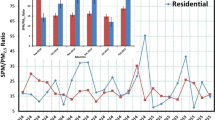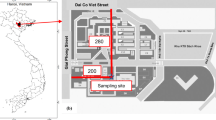Abstract
The chemical composition of the atmosphere changes rapidly due to the amount of air pollutants released every day. The aim of this research was to make an exploratory study on the chemical composition (metals and water-soluble organic fraction) of fine particulate matter (PM2.5) in a region with tropical climate. Multiple sites, with and without the influence of the construction works for the World Cup and Olympic Games, were selected in Rio de Janeiro State, RJ, Brazil. PM2.5 samples were collected every 6 days from January to December 2011. This is the first PM2.5 data generated by RJ’s monitoring network. The PM2.5 annual average concentrations in Rio de Janeiro ranged from 9 to 32 μg m−3. Metals originated from industrial (Cu, Cd, Pb) and traffic (Cr, Mn, Ni, V, and Zn) emissions, as well as those from natural emissions (Na, K, Ca, Ti, Al, Mg, Fe), were quantified. The concentrations of the metals analyzed ranged from 0.4 to 13,000 ng m−3. The highest concentrations found were related to metals present in the crust, such as Al (1.6 to 6.7 μg m−3). In the places where there was the presence of railroad minerals, Ca and Mg appeared in higher concentrations than in the other sites. Fe and PM2.5 annual and daily average were higher in areas under construction for urban mobility improvements or the Olympic arenas. Even though, the results for Ni, Pb, and Cu were 50% below WHO guidelines. Water-soluble organic carbon (WSOC) concentrations ranged from 0.8 to 4.9 μg m−3. The highest concentrations (2.4 to 4.9 μg m−3) were observed in urban areas with intense light vehicle fleet traffic as well as in areas of large industrial influence near highways with intense circulation of heavy vehicles. This is due to the fact that WSOC is mainly formed by the emissions from combustion processes. Studies are needed in order to assess to which extent the WSOC can increase the bioavailability of these and other metals.

Similar content being viewed by others
References
Adamson IYR, Prieditis H, Vincent R (1999) Pulmonary toxicity of an atmospheric particulate sample is due to the soluble fraction. Toxicol Applied Pharm 157:43–50
Arkouli M, Ulke A, Endlicher W, Baumbach G, Schultz E, Vogt U, Müller M, Dawidowski L, Faggi A, Wolf-Benning U (2010) Distribution and temporal behavior of particulate matter over the urban area of Buenos Aires. Atmos Pollut Res 1:1–8
Brazilian Institute of Geography and Statistics (IBGE) (2016). Cities population. Available at: http://www.cidades.ibge.gov.br/v3/cidades/home-cidades. Accessed Mar 2016.
Castanho AD (1999) Determinação quantitativa de fontes de material particulado na atmosfera da cidade de São Paulo. Tese de mestrado, Instituto de Física, Universidade de São Paulo. (Text in Portuguese).
Fann N, Risley D (2013) The public health context for PM2.5 and ozone air quality trends. Air Qual Atmos Health 6:1–11. doi:10.1007/s11869-010-0125-0
Fernandes MB, Brickus LSR, Moreira JC, Cardoso JN (2002) Atmospheric BTX and polyaromatic hydrocarbons in Rio de Janeiro, Brazil. Chemosphere 47(4):417–425
Figueroa DA, Rodríguez-Sierra CJ, Jiménez-Velez BD (2006) Concentrations of Ni and V, other heavy metals, arsenic, elemental and organic carbon in atmospheric fine particles (PM2.5) from Puerto Rico. Toxicol Ind Health 22(2):87–99
Gioda A, Sales JA, Cavalcanti PMS, Maia MF, Maia LFPG, Neto FRA (2004) Evaluation of air quality in Volta Redonda, the main metallurgical industrial city in Brazil. J Braz Chem Soc 15:856–864
Gioda A, Amaral BS, Monteiro ILG, Saint’pierre TD (2011) Chemical composition, sources, solubility and transport of aerosol trace elements in a tropical region. J Environ Monit 13:2134–2142
Gioda A, Ventura LMB, Ramos MB, Silva MPR (2016) Half century monitoring air pollution in a megacity: a case study of Rio de Janeiro. Water Air Soil Pollut 227:86–99
Godoy MLDP, Godoy JM, Roldão LA, Soluri DS, Donagemma RA (2009) Coarse and fine aerosol source apportionment in Rio de Janeiro, Brazil. Atmos Environ 43:2366–2374
González-Castanedo Y, Sanchez-Rodas D, Campa AMS, Pandolfi M, Alastuey A, Cachorro VE, Querol X, Rosa JD (2015) Arsenic species in atmospheric particulate matter as tracer of the air quality of Doñana Natural Park (SW Spain). Chemosphere 119:1296–1303
Guo ZG, Feng JL, Fang M, Chen HY, Lau KH (2004) The elemental and organic characteristics of PM2.5 in Asian dust episodes in Qingdao, China, 2002. Atmos Environ 38:909–919
Harrison RM, Smith DJ, Pio CA, Castro LM (1997) Comparative receptor modelling study of airbone particulate pollutants in Birmingham (United Kingdom), Coimbra (Portugal) and Lahore (Pakistan). Atmos Environ 31:3309–3321
Hennigan CJ, Miracolo MA, Engelhart GJ, May AA, Presto AA, Lee T, Sullivan AP, Mcmeeking GR, Coe H, Wold CE, Hao W-M, Gilman JB, Kuster WC, De Gouw J, Schichtel BA, Collett JL Jr, Kreidenweis SM, Robinson AL (2011) Chemical and physical transformations of organic aerosol from the photo-oxidation of open biomass burning emissions in an environmental chamber. Atmos Chem Phys 11:7669–7686
Hennigan CJ, Westervelt DM, Riipinen I, Engelhart GJ, Lee T, Collett JL, Pandis NS, Adams JP, Robinson AL (2012) New particle formation and growth in biomass burning plumes: an important source of cloud condensation nuclei. Geophys Res Letters 39(9). doi:10.1029/2012GL050930
Hueglin C, Gehrig R, Baltensperger U, Gysel M, Monn C, Vonmont H (2005) Chemical characterization of PM2.5, PM10 and coarse particles at urban, near-city and rural sites in Switzerland. Atmos Environ 39:637–651
Jhun I, Oyola P, Moreno F, Castillo M, Koutrakis P (2013) PM2.5 mass and species trends in Santiago, Chile, 1998 to 2010: the impact of fuel-related interventions and fuel sales. J Air Waste Manage Assoc 63:161–169
Kumagai K, Iijima A, Tago H, Tomioka A, Kozawa K, Sakamoto K (2009) Seasonal characteristics of water-soluble organic carbon in atmospheric particles in the inland Kanto plain, Japan. Atmos Environ 43:3345–3351
Loyola J, Arbilla G, Quiterio SL, Escaleira V, Minho AS (2012) Trace metals in the urban aerosols of Rio de Janeiro city. J Brazil Chem Soc 23:628–638
Massoud R, Shihadeh AL, Roumié M, Youness M, Gerard J, Saliba N, Zaarour R, Abboud M, Farah W, Saliba NA (2011) Intraurban variability of PM10 and PM2.5 in an Eastern Mediterranean city. Atmos Res 101:893–901
Mateus VL, Monteiro ILG, Rocha RCC, Saint'pierre TD, Gioda A (2013) Study of the chemical composition of particulate matter from the Rio de Janeiro metropolitan region, Brazil, by inductively coupled plasma-mass spectrometry and optical emission spectrometry. Spectrochim Acta B 86:131–136
Moshier E, Habre R, Rohr A, Godbold J, Nath A, Grunin A, Coull B, Petros K, Kattan M (2016) Outdoor air pollution and health effects in urban children with moderate to severe asthma. Air Qual Atmos Health 9:251–263. doi:10.1007/s11869-015-0335-6
Pope CA III, Burnett RT, Thun MJ, Call EEE, Krewski D, Ito K (2002) Lung cancer, cardiopulmonary mortality, and long-term exposure to fine particulate air pollution. JAMA 287:1132–1141
Quiterio SL, Sousa Da Silva CR, Arbilla G, Escaleira V (2004) Metals in airborne particulate matter in the industrial district of Santa Cruz, Rio de Janeiro, in an annual period. Atmos Environ 38:321–331
Ramos CA, Wolterbeek HT, Almeida SM (2016) Air pollutant exposure and inhaled dose during urban commuting: a comparison between cycling and motorized modes. Air Qual Atmos Health 9:867–879. doi:10.1007/s11869-015-0389-5
Rodríguez-Cotto RI, Ortiz-Martínez MG, Rivera-Ramírez E, Mateus VL, Amaral BS, Jiménez-Vélez BD, Gioda A (2014) Particle pollution in Rio de Janeiro, Brazil: increase and decrease of pro-inflammatory cytokines IL-6 and IL-8 in human lung cells. Environ Pollut 194:112–120
Saxena P, Hildemann LM (1996) Water-soluble organics in atmospheric particles: a critical review of the literature and application of thermodynamics to identify candidate compounds. J Atmos Chem 24:57–109
Soluri DS, Godoy MLP, Godoy JM, Roldão LA (2007) Multi-site PM2.5 and PM2.5-10 aerosol source apportionment in Rio de Janeiro, Brazil. J Braz Chem Soc 18:838–845
Tao J, Zhang L, Engling G, Zhang R, Yang Y, Cao J, Zhu C, Wang Q, Luo L (2013) Chemical composition of PM2.5 in an urban environment in Chengdu, China: importance of springtime dust storms and biomass burning. Atmos Res 122:270–283
Terrouche A, Ali-Khodja H, Kemmouche A, Bouziane M, Derradji A, Charron A (2016) Identification of sources of atmospheric particulate matter and trace metals in Constantine. Air Qual Atmos Health 9:69–82. doi:10.1007/s11869-014-0308-1
Traversi D, Degan R, Marco R, Gilli G, Pignata C, Villani S, Bono R (2009) Mutagenic properties of PM2.5 urban pollution in the Northern Italy: the nitro-compounds contribution. Environ Int 35:905–910
Urban RC, Lima-Souza M, Caetano-Silva L, Queiroz MEC, Nogueira RFP, Allen AG, Cardoso AA, Held G, Campos MLAM (2012) Use of levoglucosan, potassium, and water-soluble organic carbon to characterize the origins of biomass-burning aerosols. Atmos Environ 61:562–569
US Environmental Protection Agency (USEPA) (2006) 40 CFR Part 50, Rules and regulations. national ambient air quality standards for particulate matter; Final Rule. Federal Register. V 71, n°. 200.
Ventura LMB, Amaral BS, Wanderley KB, Godoy JM, Gioda A (2014) Validation method to determine metals in atmospheric particulate matter by inductively coupled plasma optical emission spectrometry. J Braz Chem Soc 25:1571–1582
Voutsa D, Samara C, Manoli E, Lazarou D, Tzoumaka P (2014) Ionic composition of PM2.5 at urban sites of northern Greece: secondary inorganic aerosol formation. Environ Sci Pollut Res 21:4995–5006
Wallace J, Kanaroglou P (2009) The effect of temperature inversions on ground-level nitrogen dioxide (NO2) and fine particulate matter (PM2.5) using temperature profiles from the atmospheric infrared sounder (AIRS). Sci Total Environ 407:5085–5095
World Health Organization (WHO) (2000) Air quality guidelines for Europe. WHO Regional Publications, Eur. Ser. No. 91
World Health Organization (WHO) (2006) Air quality guidelines for particulate matter, ozone, nitrogen dioxide and sulphur dioxide, global update 2005. Summary of Risk Assessment.
Wozniak AS, Shelley RU, Sleighter RL, Abdulla HAN, Morton PL, Landing WM, Hatcher PG (2013) Relationships among aerosol water-soluble organic matter, iron and aluminum in European, North African, and Marine air masses from the 2010 US GEOTRACES cruise. Marine Chem 154:24–33
Acknowledgments
The authors are grateful to the Rio de Janeiro State Environment Institute (INEA) for PM data, and FAPERJ and CNPq for financial support. They are also grateful to Prof. Dr. Ricardo Aucélio for sharing their technical infrastructure for TOC analysis.
Author information
Authors and Affiliations
Corresponding author
Ethics declarations
Conflict of interest
The authors declare that they have no conflict of interest.
Electronic supplementary material
Table S1
(DOCX 16 kb)
Rights and permissions
About this article
Cite this article
Ventura, L.M.B., Mateus, V.L., de Almeida, A.C.S.L. et al. Chemical composition of fine particles (PM2.5): water-soluble organic fraction and trace metals. Air Qual Atmos Health 10, 845–852 (2017). https://doi.org/10.1007/s11869-017-0474-z
Received:
Accepted:
Published:
Issue Date:
DOI: https://doi.org/10.1007/s11869-017-0474-z




